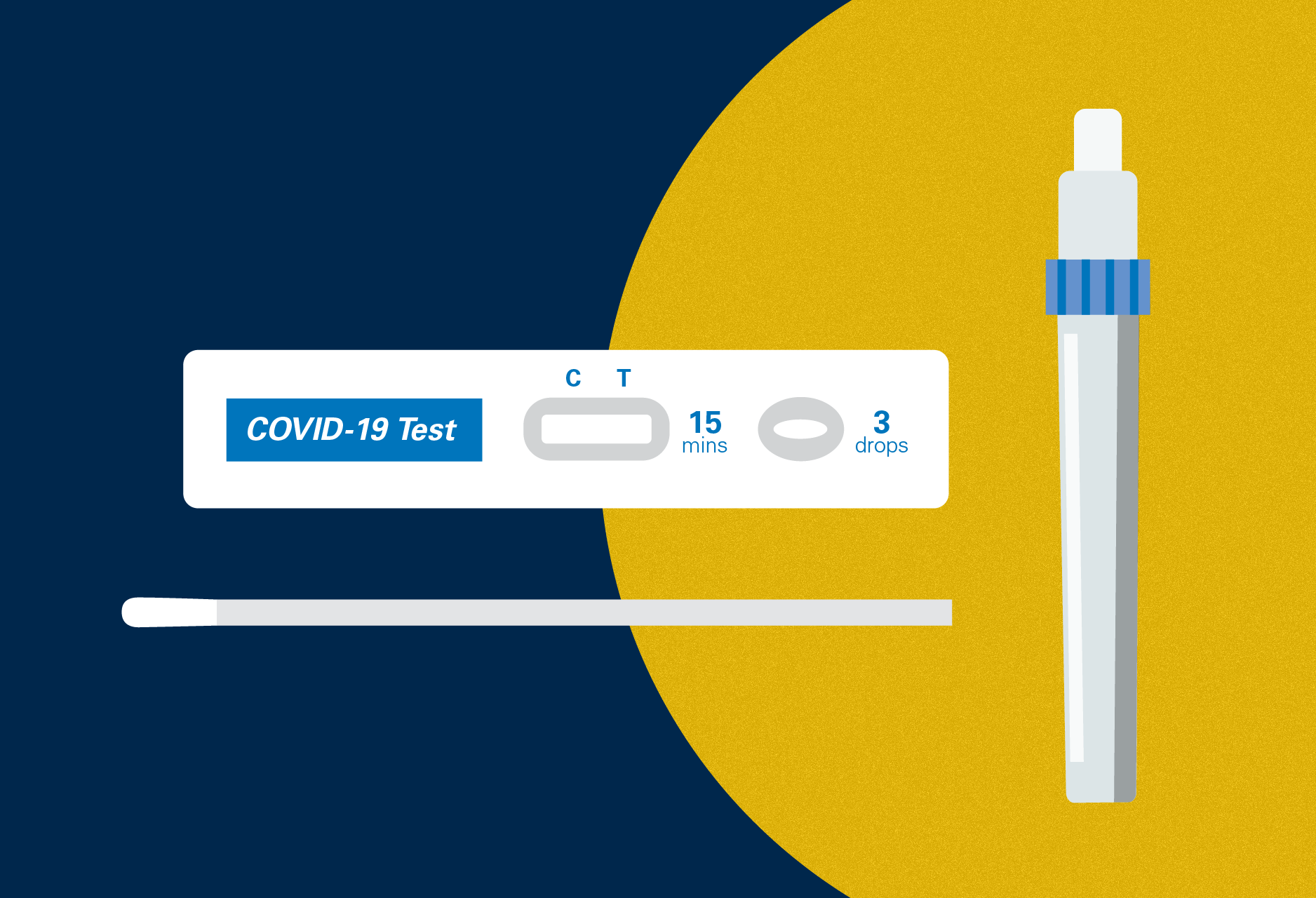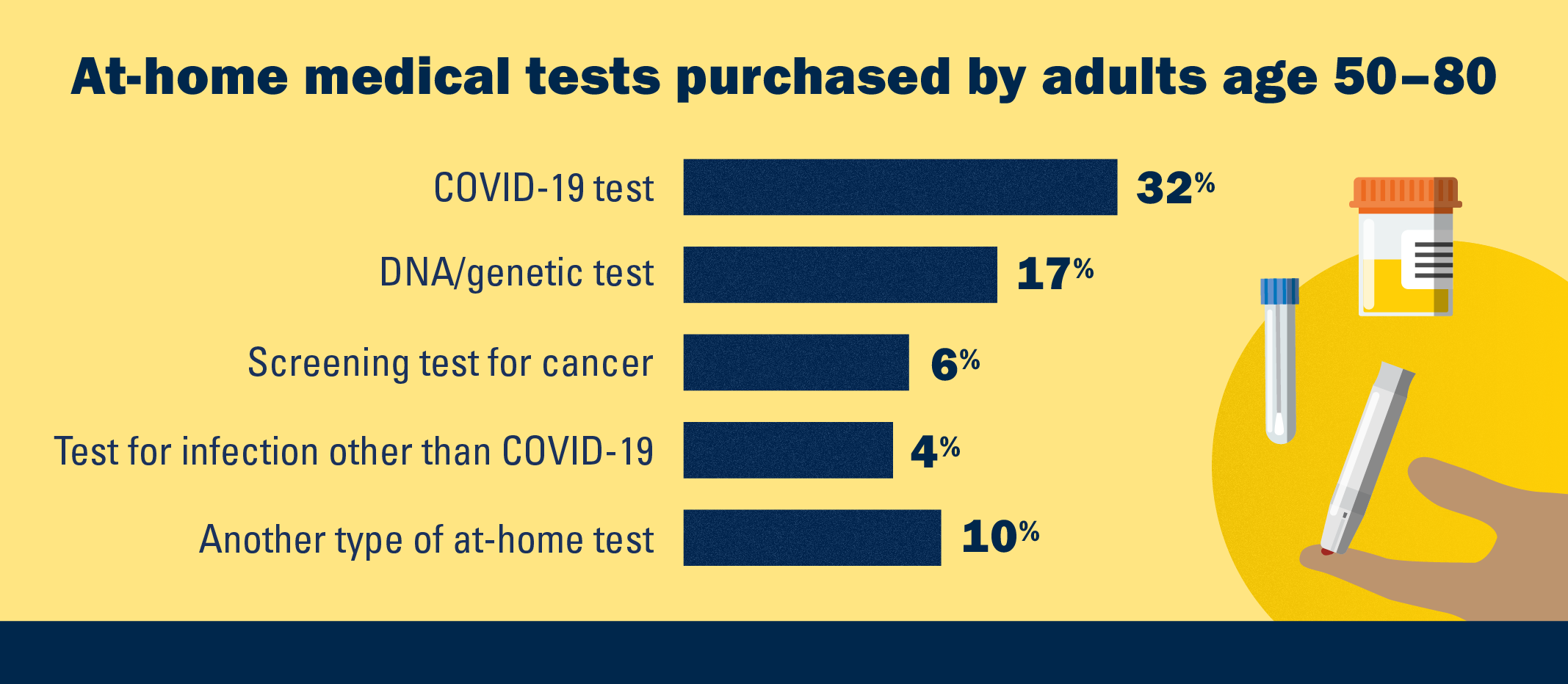
At-home medical tests are used to screen for or monitor certain diseases and conditions, including infections such as COVID-19, and some cancers. Most of these tests, also known as direct-to-consumer tests, involve the collection of blood, urine, or saliva at home, and can be bought online or at a store such as a supermarket or pharmacy. In July 2022, the University of Michigan National Poll on Healthy Aging asked a national sample of adults age 50–80 about their use and experiences with any at-home medical tests they had purchased, as well as their future interest in such tests.
Buying at-home medical tests
Nearly half of adults age 50–80 (48%) had ever bought an at-home medical test. About one in three older adults (32%) had ever purchased an at-home test for COVID-19, while 28% reported having ever bought at least one of these types of at-home medical tests: a DNA/genetic test (e.g., 23andMe or AncestryDNA) (17%), a screening test for cancer (e.g., colon or prostate cancer) (6%), a test for an infection other than COVID-19 (e.g., HIV or a urinary tract infection) (4%), or some other type of at-home test (e.g., an allergy, hormone, or food sensitivity test) (10%). One in five adults age 50–80 (20%) had only purchased an at-home test for COVID-19, 16% purchased only another type of at-home test, and 12% had bought both a COVID-19 test and another type of test.
White and Hispanic older adults were more likely than Black older adults to have bought a COVID-19 test (33% vs. 33% vs. 20%) as well as other types of at-home medical tests (30% vs. 29% vs. 16%). Adults age 50–64 were more likely than those age 65–80 to have bought a COVID-19 test (36% vs. 28%). Older adults with higher levels of education, in higher income households, and who were married or partnered were also more likely to have bought a COVID-19 test or any other type of at-home medical test.
Among those who bought an at-home DNA/genetic test, 44% said they heard about it from an advertisement and 37% said family or friends recommended it. Among those who bought an at-home screening test for cancer, 67% said it was recommended by their primary care provider, and 11% said they heard about it through an advertisement. For those who bought an at-home test for an infection other than COVID-19, 23% received a recommendation from their health care provider, and the same percentage said family or friends recommended the test.

Sharing results with primary care providers
Nearly all adults age 50–80 (92%) thought that at-home medical tests should be discussed with their doctor. Among older adults who bought and used an at-home screening test for cancer, 90% shared their test results with their primary care provider. More than half of those who bought and used an at-home test for infection (55%) shared the results with their primary care provider. Fewer than one in ten older adults who bought and used a DNA/genetic test (9%) shared the results with their primary care provider.
Perspectives on at-home medical tests
Most older adults who bought a non-COVID-19 at-home medical test believed that the test was worth what they paid for it, including 87% of those who bought a screening test for cancer, 79% of those who bought a test for a non-COVID-19 infection, and 77% of those who bought a DNA/genetic test.
Overall, three in four adults age 50–80 (74%) believed at-home tests are more convenient than tests through their health care provider, 62% agreed that at-home tests are a good value, 59% thought that these tests can be trusted to give reliable results, and 53% believed that at-home tests are regulated by the government.
Future interest in using at-home tests
Most adults age 50–80 (82%) were very or somewhat interested in using an at-home medical test in the future. Older adults were most interested in a test for COVID-19 (70%) followed by a test for cancer (56%), a test for an infection other than COVID-19 (43%), a DNA/genetic test (40%), an allergy test (37%), a food sensitivity test (30%), and a hormone test (25%). Older adults who had bought an at-home test in the past were more likely to be interested in using at-home tests in the future (93% vs. 78%), as were women compared with men (87% vs. 77%). In addition, those with higher levels of education and household income more commonly expressed interest in using an at-home medical test in the future.
Among older adults who were not interested in using an at-home medical test in the future, 67% said it was because they could get the tests they needed through their doctor. Other reasons for not being interested included the following: not needing them for their health concerns (27%), never having thought about them (26%), lack of trust in the results (18%), believing that they are not worth the cost (15%), and being unable to afford the tests (6%).
Implications
Nearly half of older adults have purchased at least one at-home medical test, and more than four in five expressed interest in using them in the future. Improved technology, marketing, and convenience are among the factors fueling growing interest in at-home medical tests. Use of at-home medical tests has become increasingly common for COVID-19, yet this poll also demonstrates that nearly as many older adults have bought some other type of at-home test such as for DNA/genetic testing, cancer screening, or for other types of infection.
While nearly all adults age 50–80 believe that at-home medical test results should be discussed with their doctor, many older adults who used an at-home test did not share their results. For example, nearly half of those who took a test for an infection other than COVID-19 had not shared their results with their primary care provider. It is important that older adults who use at-home medical tests understand when, why, and how to share the results of these tests with those involved in their care.
These results suggest many older adults feel that at-home medical tests are a convenient way to screen for or monitor certain diseases and conditions. At the same time, fewer older adults believe that at-home medical tests are a good value, can be trusted, or are regulated by the government. Many at-home medical tests are not regulated by any formal organization, and consumers should be aware of the accuracy and limitations of the tests, as well as the consequences of certain types of results (e.g., genetic test results may also have implications for the health of blood relatives). Because at-home tests can be fairly expensive and typically are not covered by insurance, policymakers and regulatory agencies have important roles to play in ensuring that older adults who are interested in purchasing at-home tests can be confident in the information they will receive from them.
As at-home medical tests become more common, health care providers and researchers should identify ways these tests can add value to traditional health care encounters and help older adults be more engaged in assessing their own health risks and needs. Sharing and discussing clinically significant test results with health care providers is important in deciding if further testing or treatment may be necessary.
Data Source and Methods
This National Poll on Healthy Aging report presents findings from a nationally representative household survey conducted exclusively by NORC at the University of Chicago for the University of Michigan’s Institute for Healthcare Policy and Innovation. National Poll on Healthy Aging surveys are conducted using NORC’s AmeriSpeak probability-based panel. This survey module was administered online and via phone in July 2022 to a randomly selected, stratified group of U.S. adults age 50–80 (n=2,163). The sample was subsequently weighted to reflect population figures from the U.S. Census Bureau. The completion rate was 75% among panel members contacted to participate. The margin of error is ±1 to 3 percentage points for questions asked of the full sample and higher among subgroups.
Findings from the National Poll on Healthy Aging do not represent the opinions of the University of Michigan. The University of Michigan reserves all rights over this material.
Read other National Poll on Healthy Aging reports and about our Michigan findings, and learn about the poll methodology.
Citation
Kullgren J, Singer D, Kirch M, Solway E, Smith E, Hutchens L, Malani P. At-Home Medical Tests. University of Michigan National Poll on Healthy Aging. October 2022. Available at: https://dx.doi.org/10.7302/6556
Scholarly Publications
Rager JB, Kirch M, Singer DC, et al. Use of At-Home Medical Tests Among Older US Adults: A Nationally Representative Survey. INQUIRY: The Journal of Health Care Organization, Provision, and Financing. 2024;61. doi:10.1177/00469580241284168